Forest School: Learning Perspectives of Primary School Practitioners
VerifiedAdded on 2023/05/30
|42
|13340
|155
Report
AI Summary
This report investigates forest school practitioners' perceptions of learning to identify the topics covered, learning styles, and philosophies underpinning its delivery. Based on interviews with experienced forest school practitioners, the study reveals a focus on social development (teamwork, relationships, self-knowledge, and risk-taking), alongside engagement with nature. Learning styles were found to be kinaesthetic, sensory, and experiential. Forest school leaders viewed themselves as facilitators of child-led learning, negotiating learning as children gained confidence. The research highlights the importance of outdoor learning in primary teaching, providing a deeper analysis of how practitioners facilitate different types of learning at forest school and its place alongside classroom teaching, revealing that although parts of the national curriculum could be taught in forest school, practitioners focus more on personal, social and emotional development. There is also development of skills (e.g. tool use), employing kinaesthetic and sensory learning approaches rather than focussing on nature education and science per se.
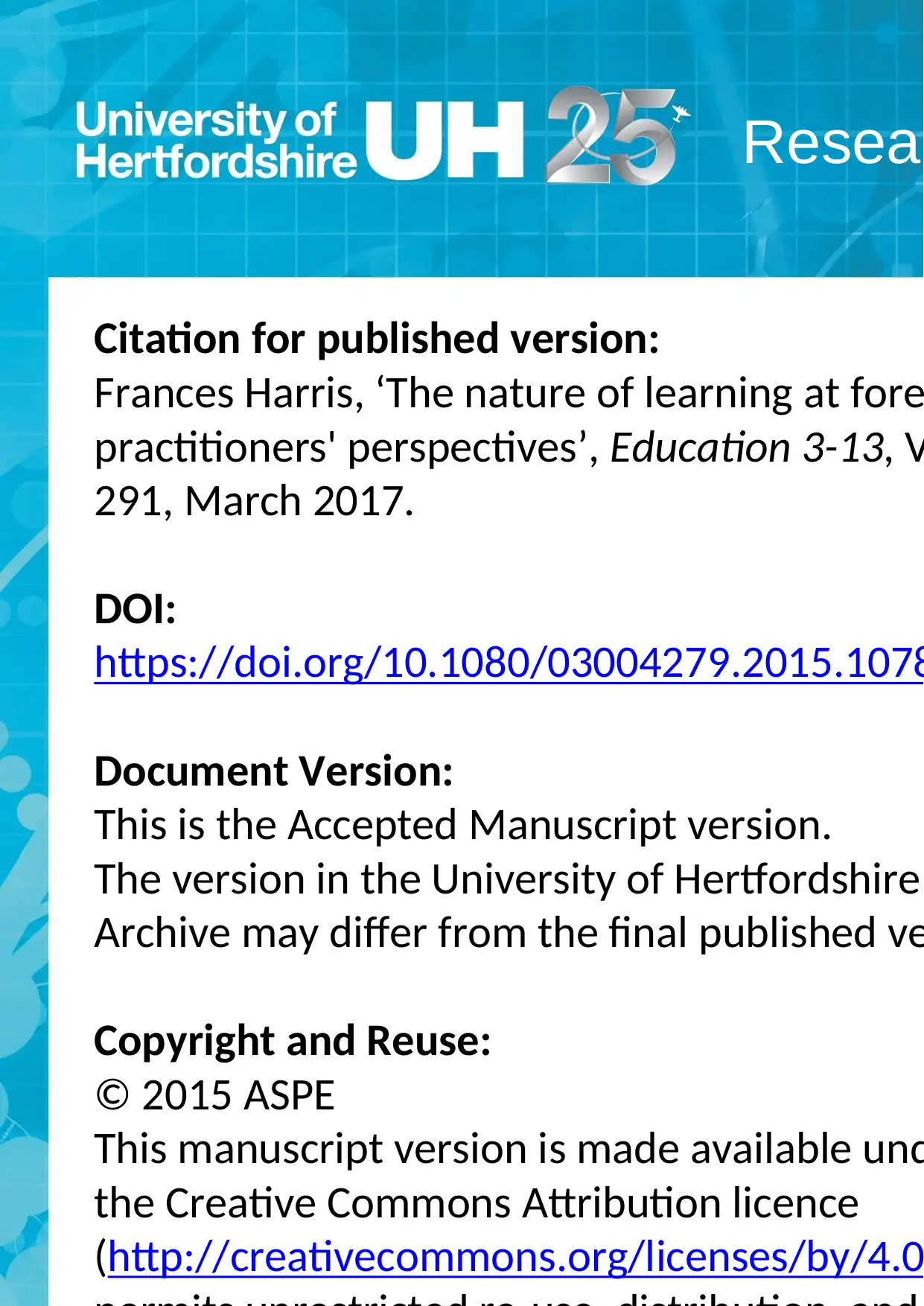
Resear
Citation for published version:
Frances Harris, ‘The nature of learning at fore
practitioners' perspectives’, Education 3-13, V
291, March 2017.
DOI:
https://doi.org/10.1080/03004279.2015.1078
Document Version:
This is the Accepted Manuscript version.
The version in the University of Hertfordshire
Archive may differ from the final published ve
Copyright and Reuse:
© 2015 ASPE
This manuscript version is made available und
the Creative Commons Attribution licence
(http://creativecommons.org/licenses/by/4.0
Citation for published version:
Frances Harris, ‘The nature of learning at fore
practitioners' perspectives’, Education 3-13, V
291, March 2017.
DOI:
https://doi.org/10.1080/03004279.2015.1078
Document Version:
This is the Accepted Manuscript version.
The version in the University of Hertfordshire
Archive may differ from the final published ve
Copyright and Reuse:
© 2015 ASPE
This manuscript version is made available und
the Creative Commons Attribution licence
(http://creativecommons.org/licenses/by/4.0
Paraphrase This Document
Need a fresh take? Get an instant paraphrase of this document with our AI Paraphraser
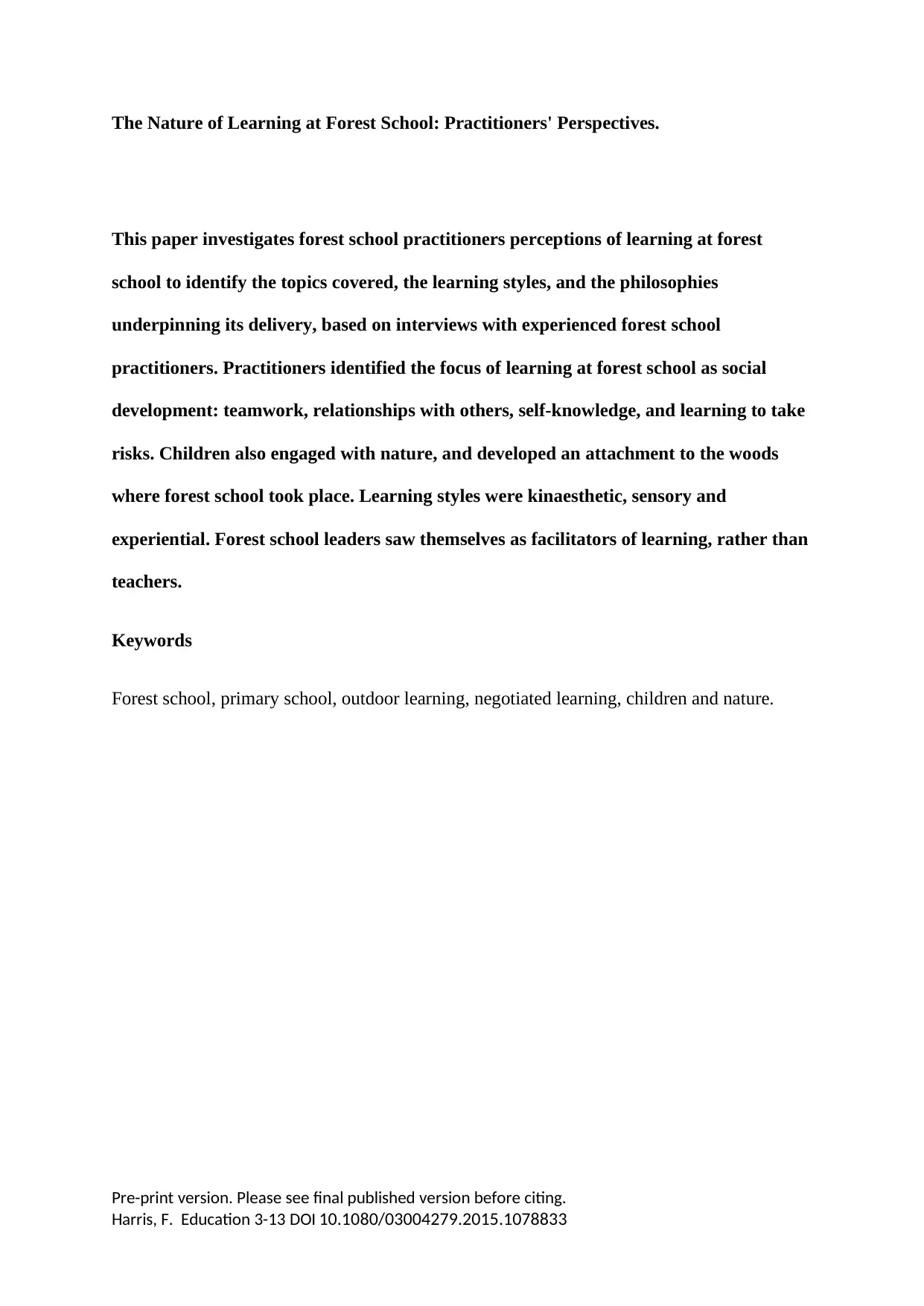
Pre-print version. Please see final published version before citing.
Harris, F. Education 3-13 DOI 10.1080/03004279.2015.1078833
The Nature of Learning at Forest School: Practitioners' Perspectives.
This paper investigates forest school practitioners perceptions of learning at forest
school to identify the topics covered, the learning styles, and the philosophies
underpinning its delivery, based on interviews with experienced forest school
practitioners. Practitioners identified the focus of learning at forest school as social
development: teamwork, relationships with others, self-knowledge, and learning to take
risks. Children also engaged with nature, and developed an attachment to the woods
where forest school took place. Learning styles were kinaesthetic, sensory and
experiential. Forest school leaders saw themselves as facilitators of learning, rather than
teachers.
Keywords
Forest school, primary school, outdoor learning, negotiated learning, children and nature.
Harris, F. Education 3-13 DOI 10.1080/03004279.2015.1078833
The Nature of Learning at Forest School: Practitioners' Perspectives.
This paper investigates forest school practitioners perceptions of learning at forest
school to identify the topics covered, the learning styles, and the philosophies
underpinning its delivery, based on interviews with experienced forest school
practitioners. Practitioners identified the focus of learning at forest school as social
development: teamwork, relationships with others, self-knowledge, and learning to take
risks. Children also engaged with nature, and developed an attachment to the woods
where forest school took place. Learning styles were kinaesthetic, sensory and
experiential. Forest school leaders saw themselves as facilitators of learning, rather than
teachers.
Keywords
Forest school, primary school, outdoor learning, negotiated learning, children and nature.
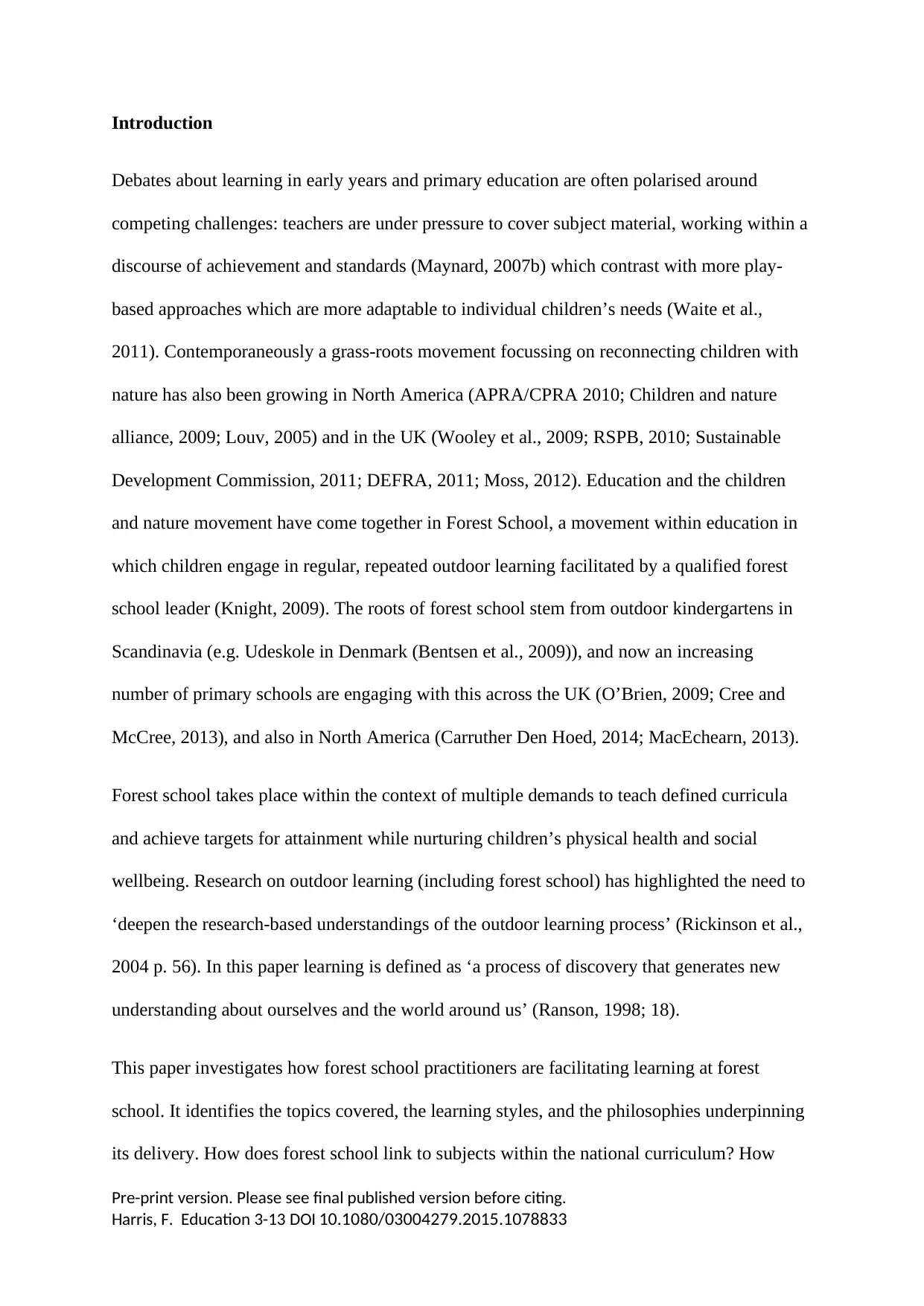
Pre-print version. Please see final published version before citing.
Harris, F. Education 3-13 DOI 10.1080/03004279.2015.1078833
Introduction
Debates about learning in early years and primary education are often polarised around
competing challenges: teachers are under pressure to cover subject material, working within a
discourse of achievement and standards (Maynard, 2007b) which contrast with more play-
based approaches which are more adaptable to individual children’s needs (Waite et al.,
2011). Contemporaneously a grass-roots movement focussing on reconnecting children with
nature has also been growing in North America (APRA/CPRA 2010; Children and nature
alliance, 2009; Louv, 2005) and in the UK (Wooley et al., 2009; RSPB, 2010; Sustainable
Development Commission, 2011; DEFRA, 2011; Moss, 2012). Education and the children
and nature movement have come together in Forest School, a movement within education in
which children engage in regular, repeated outdoor learning facilitated by a qualified forest
school leader (Knight, 2009). The roots of forest school stem from outdoor kindergartens in
Scandinavia (e.g. Udeskole in Denmark (Bentsen et al., 2009)), and now an increasing
number of primary schools are engaging with this across the UK (O’Brien, 2009; Cree and
McCree, 2013), and also in North America (Carruther Den Hoed, 2014; MacEchearn, 2013).
Forest school takes place within the context of multiple demands to teach defined curricula
and achieve targets for attainment while nurturing children’s physical health and social
wellbeing. Research on outdoor learning (including forest school) has highlighted the need to
‘deepen the research-based understandings of the outdoor learning process’ (Rickinson et al.,
2004 p. 56). In this paper learning is defined as ‘a process of discovery that generates new
understanding about ourselves and the world around us’ (Ranson, 1998; 18).
This paper investigates how forest school practitioners are facilitating learning at forest
school. It identifies the topics covered, the learning styles, and the philosophies underpinning
its delivery. How does forest school link to subjects within the national curriculum? How
Harris, F. Education 3-13 DOI 10.1080/03004279.2015.1078833
Introduction
Debates about learning in early years and primary education are often polarised around
competing challenges: teachers are under pressure to cover subject material, working within a
discourse of achievement and standards (Maynard, 2007b) which contrast with more play-
based approaches which are more adaptable to individual children’s needs (Waite et al.,
2011). Contemporaneously a grass-roots movement focussing on reconnecting children with
nature has also been growing in North America (APRA/CPRA 2010; Children and nature
alliance, 2009; Louv, 2005) and in the UK (Wooley et al., 2009; RSPB, 2010; Sustainable
Development Commission, 2011; DEFRA, 2011; Moss, 2012). Education and the children
and nature movement have come together in Forest School, a movement within education in
which children engage in regular, repeated outdoor learning facilitated by a qualified forest
school leader (Knight, 2009). The roots of forest school stem from outdoor kindergartens in
Scandinavia (e.g. Udeskole in Denmark (Bentsen et al., 2009)), and now an increasing
number of primary schools are engaging with this across the UK (O’Brien, 2009; Cree and
McCree, 2013), and also in North America (Carruther Den Hoed, 2014; MacEchearn, 2013).
Forest school takes place within the context of multiple demands to teach defined curricula
and achieve targets for attainment while nurturing children’s physical health and social
wellbeing. Research on outdoor learning (including forest school) has highlighted the need to
‘deepen the research-based understandings of the outdoor learning process’ (Rickinson et al.,
2004 p. 56). In this paper learning is defined as ‘a process of discovery that generates new
understanding about ourselves and the world around us’ (Ranson, 1998; 18).
This paper investigates how forest school practitioners are facilitating learning at forest
school. It identifies the topics covered, the learning styles, and the philosophies underpinning
its delivery. How does forest school link to subjects within the national curriculum? How
⊘ This is a preview!⊘
Do you want full access?
Subscribe today to unlock all pages.

Trusted by 1+ million students worldwide
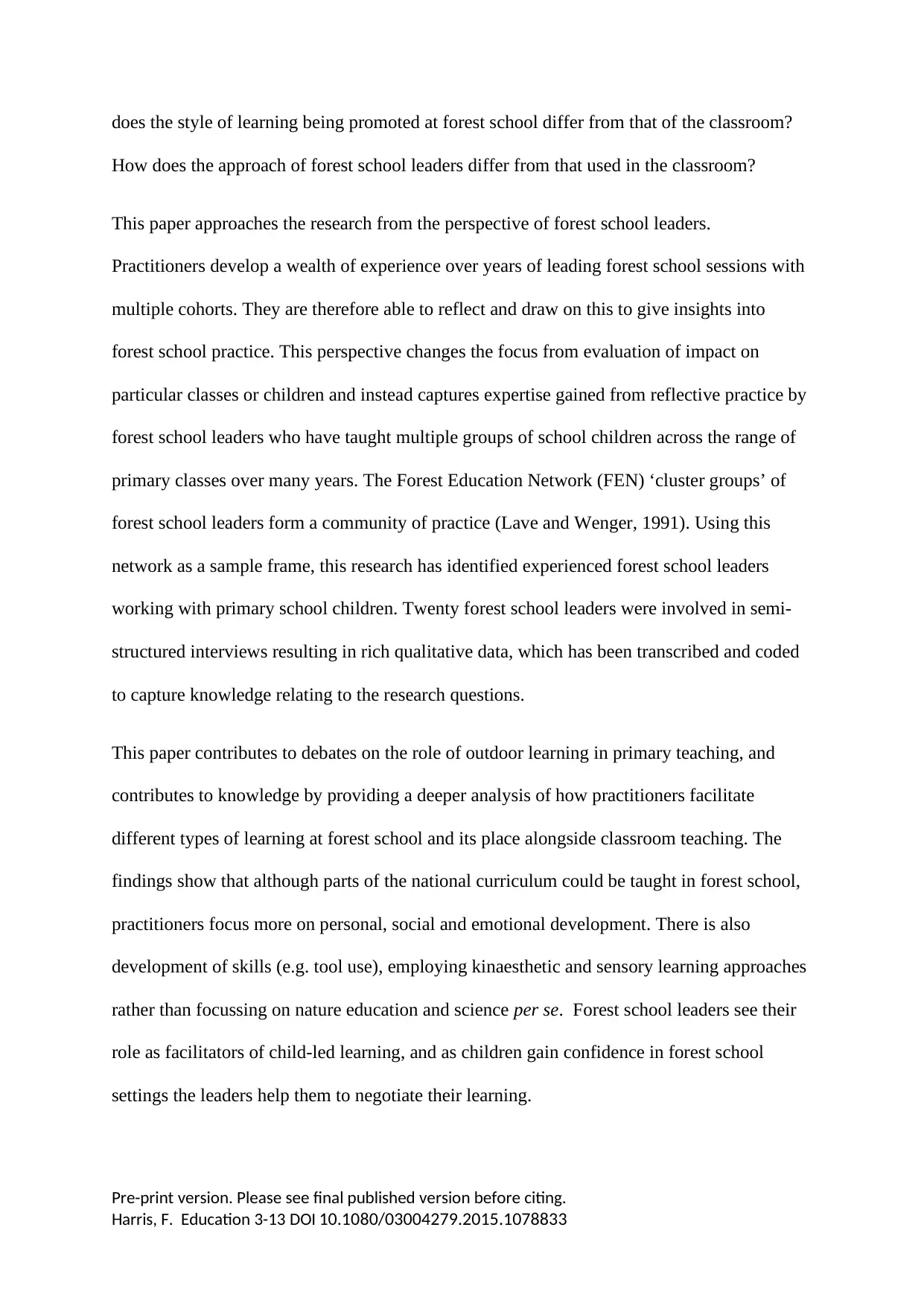
Pre-print version. Please see final published version before citing.
Harris, F. Education 3-13 DOI 10.1080/03004279.2015.1078833
does the style of learning being promoted at forest school differ from that of the classroom?
How does the approach of forest school leaders differ from that used in the classroom?
This paper approaches the research from the perspective of forest school leaders.
Practitioners develop a wealth of experience over years of leading forest school sessions with
multiple cohorts. They are therefore able to reflect and draw on this to give insights into
forest school practice. This perspective changes the focus from evaluation of impact on
particular classes or children and instead captures expertise gained from reflective practice by
forest school leaders who have taught multiple groups of school children across the range of
primary classes over many years. The Forest Education Network (FEN) ‘cluster groups’ of
forest school leaders form a community of practice (Lave and Wenger, 1991). Using this
network as a sample frame, this research has identified experienced forest school leaders
working with primary school children. Twenty forest school leaders were involved in semi-
structured interviews resulting in rich qualitative data, which has been transcribed and coded
to capture knowledge relating to the research questions.
This paper contributes to debates on the role of outdoor learning in primary teaching, and
contributes to knowledge by providing a deeper analysis of how practitioners facilitate
different types of learning at forest school and its place alongside classroom teaching. The
findings show that although parts of the national curriculum could be taught in forest school,
practitioners focus more on personal, social and emotional development. There is also
development of skills (e.g. tool use), employing kinaesthetic and sensory learning approaches
rather than focussing on nature education and science per se. Forest school leaders see their
role as facilitators of child-led learning, and as children gain confidence in forest school
settings the leaders help them to negotiate their learning.
Harris, F. Education 3-13 DOI 10.1080/03004279.2015.1078833
does the style of learning being promoted at forest school differ from that of the classroom?
How does the approach of forest school leaders differ from that used in the classroom?
This paper approaches the research from the perspective of forest school leaders.
Practitioners develop a wealth of experience over years of leading forest school sessions with
multiple cohorts. They are therefore able to reflect and draw on this to give insights into
forest school practice. This perspective changes the focus from evaluation of impact on
particular classes or children and instead captures expertise gained from reflective practice by
forest school leaders who have taught multiple groups of school children across the range of
primary classes over many years. The Forest Education Network (FEN) ‘cluster groups’ of
forest school leaders form a community of practice (Lave and Wenger, 1991). Using this
network as a sample frame, this research has identified experienced forest school leaders
working with primary school children. Twenty forest school leaders were involved in semi-
structured interviews resulting in rich qualitative data, which has been transcribed and coded
to capture knowledge relating to the research questions.
This paper contributes to debates on the role of outdoor learning in primary teaching, and
contributes to knowledge by providing a deeper analysis of how practitioners facilitate
different types of learning at forest school and its place alongside classroom teaching. The
findings show that although parts of the national curriculum could be taught in forest school,
practitioners focus more on personal, social and emotional development. There is also
development of skills (e.g. tool use), employing kinaesthetic and sensory learning approaches
rather than focussing on nature education and science per se. Forest school leaders see their
role as facilitators of child-led learning, and as children gain confidence in forest school
settings the leaders help them to negotiate their learning.
Paraphrase This Document
Need a fresh take? Get an instant paraphrase of this document with our AI Paraphraser
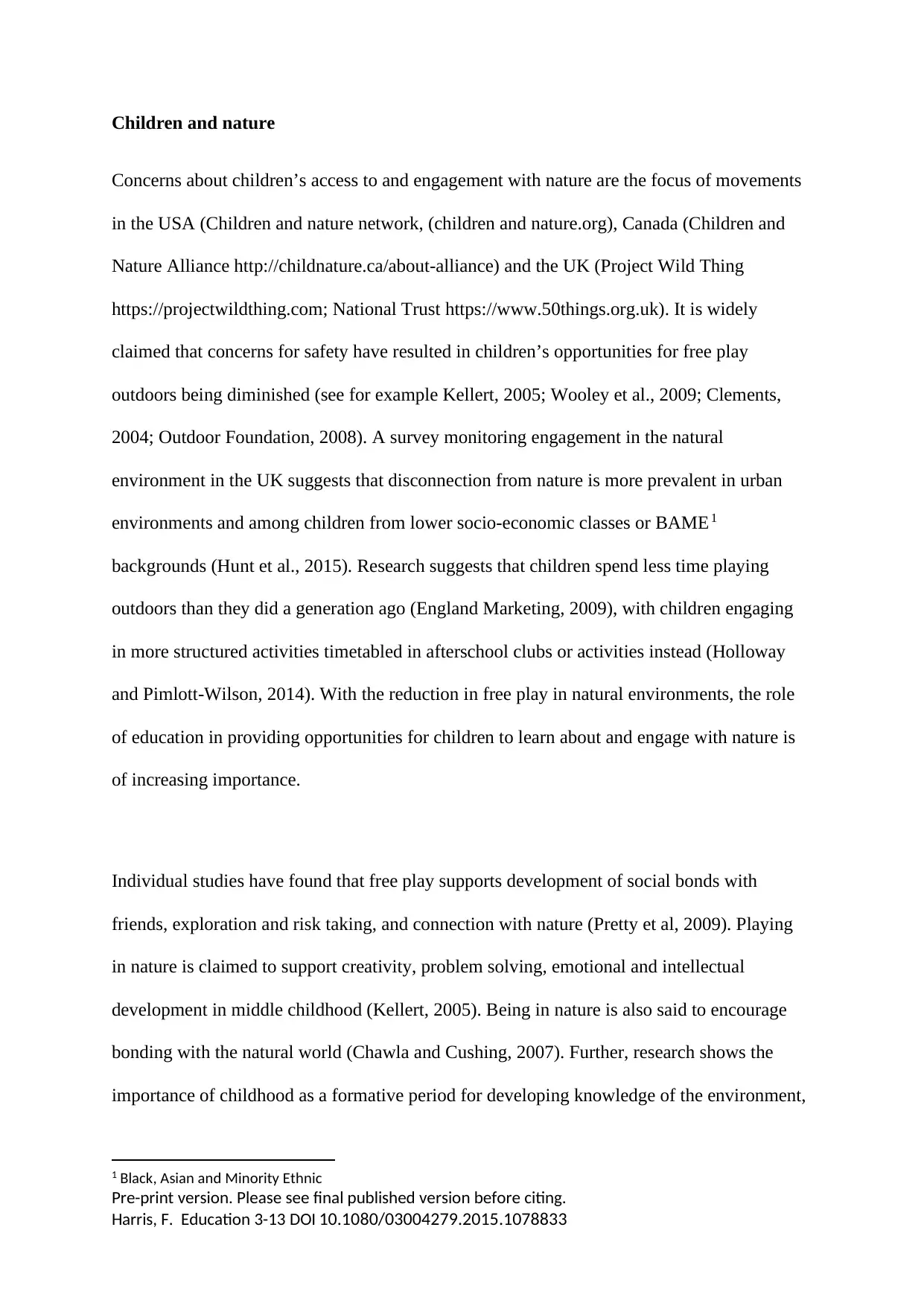
Pre-print version. Please see final published version before citing.
Harris, F. Education 3-13 DOI 10.1080/03004279.2015.1078833
Children and nature
Concerns about children’s access to and engagement with nature are the focus of movements
in the USA (Children and nature network, (children and nature.org), Canada (Children and
Nature Alliance http://childnature.ca/about-alliance) and the UK (Project Wild Thing
https://projectwildthing.com; National Trust https://www.50things.org.uk). It is widely
claimed that concerns for safety have resulted in children’s opportunities for free play
outdoors being diminished (see for example Kellert, 2005; Wooley et al., 2009; Clements,
2004; Outdoor Foundation, 2008). A survey monitoring engagement in the natural
environment in the UK suggests that disconnection from nature is more prevalent in urban
environments and among children from lower socio-economic classes or BAME 1
backgrounds (Hunt et al., 2015). Research suggests that children spend less time playing
outdoors than they did a generation ago (England Marketing, 2009), with children engaging
in more structured activities timetabled in afterschool clubs or activities instead (Holloway
and Pimlott-Wilson, 2014). With the reduction in free play in natural environments, the role
of education in providing opportunities for children to learn about and engage with nature is
of increasing importance.
Individual studies have found that free play supports development of social bonds with
friends, exploration and risk taking, and connection with nature (Pretty et al, 2009). Playing
in nature is claimed to support creativity, problem solving, emotional and intellectual
development in middle childhood (Kellert, 2005). Being in nature is also said to encourage
bonding with the natural world (Chawla and Cushing, 2007). Further, research shows the
importance of childhood as a formative period for developing knowledge of the environment,
1 Black, Asian and Minority Ethnic
Harris, F. Education 3-13 DOI 10.1080/03004279.2015.1078833
Children and nature
Concerns about children’s access to and engagement with nature are the focus of movements
in the USA (Children and nature network, (children and nature.org), Canada (Children and
Nature Alliance http://childnature.ca/about-alliance) and the UK (Project Wild Thing
https://projectwildthing.com; National Trust https://www.50things.org.uk). It is widely
claimed that concerns for safety have resulted in children’s opportunities for free play
outdoors being diminished (see for example Kellert, 2005; Wooley et al., 2009; Clements,
2004; Outdoor Foundation, 2008). A survey monitoring engagement in the natural
environment in the UK suggests that disconnection from nature is more prevalent in urban
environments and among children from lower socio-economic classes or BAME 1
backgrounds (Hunt et al., 2015). Research suggests that children spend less time playing
outdoors than they did a generation ago (England Marketing, 2009), with children engaging
in more structured activities timetabled in afterschool clubs or activities instead (Holloway
and Pimlott-Wilson, 2014). With the reduction in free play in natural environments, the role
of education in providing opportunities for children to learn about and engage with nature is
of increasing importance.
Individual studies have found that free play supports development of social bonds with
friends, exploration and risk taking, and connection with nature (Pretty et al, 2009). Playing
in nature is claimed to support creativity, problem solving, emotional and intellectual
development in middle childhood (Kellert, 2005). Being in nature is also said to encourage
bonding with the natural world (Chawla and Cushing, 2007). Further, research shows the
importance of childhood as a formative period for developing knowledge of the environment,
1 Black, Asian and Minority Ethnic
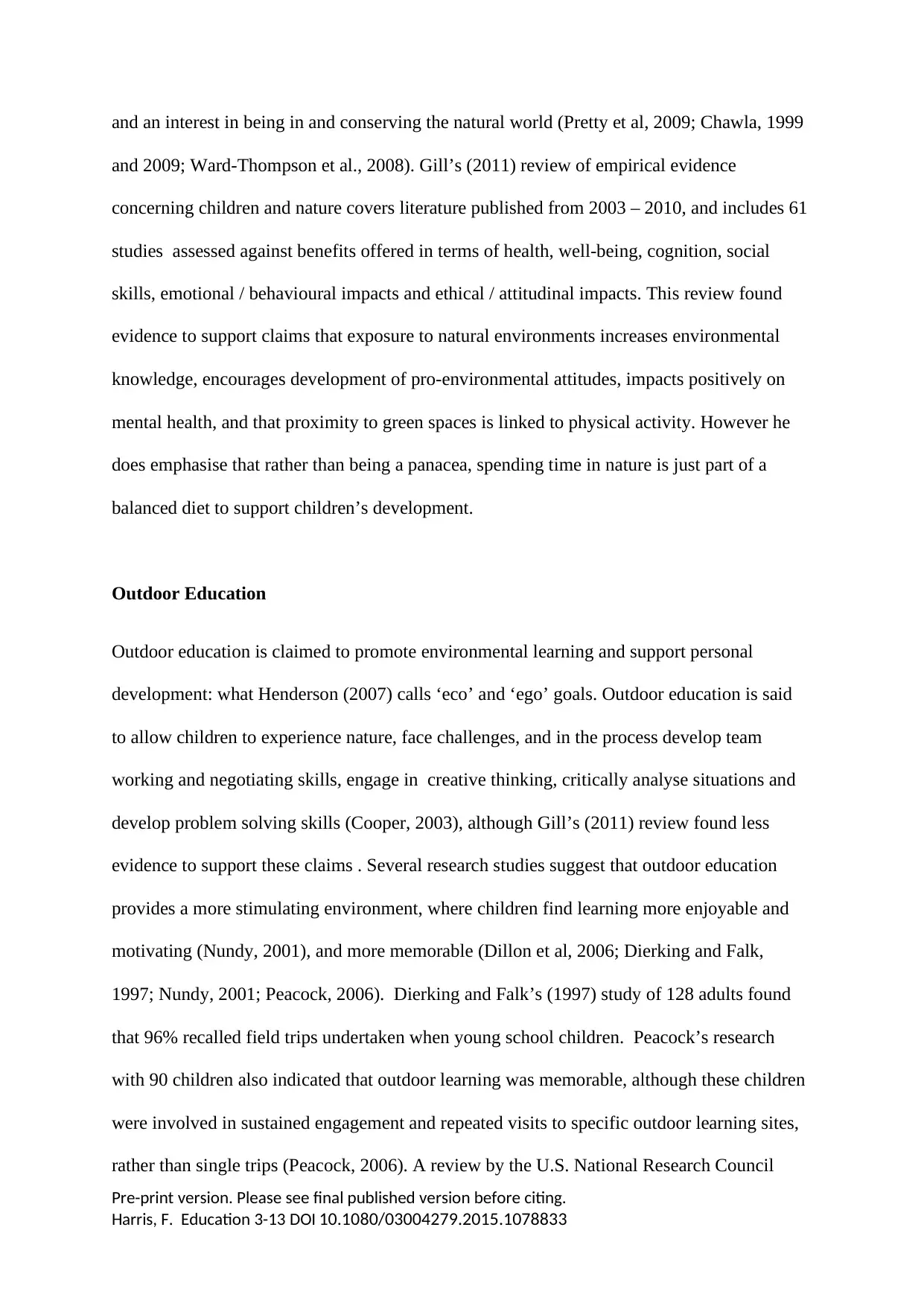
Pre-print version. Please see final published version before citing.
Harris, F. Education 3-13 DOI 10.1080/03004279.2015.1078833
and an interest in being in and conserving the natural world (Pretty et al, 2009; Chawla, 1999
and 2009; Ward-Thompson et al., 2008). Gill’s (2011) review of empirical evidence
concerning children and nature covers literature published from 2003 – 2010, and includes 61
studies assessed against benefits offered in terms of health, well-being, cognition, social
skills, emotional / behavioural impacts and ethical / attitudinal impacts. This review found
evidence to support claims that exposure to natural environments increases environmental
knowledge, encourages development of pro-environmental attitudes, impacts positively on
mental health, and that proximity to green spaces is linked to physical activity. However he
does emphasise that rather than being a panacea, spending time in nature is just part of a
balanced diet to support children’s development.
Outdoor Education
Outdoor education is claimed to promote environmental learning and support personal
development: what Henderson (2007) calls ‘eco’ and ‘ego’ goals. Outdoor education is said
to allow children to experience nature, face challenges, and in the process develop team
working and negotiating skills, engage in creative thinking, critically analyse situations and
develop problem solving skills (Cooper, 2003), although Gill’s (2011) review found less
evidence to support these claims . Several research studies suggest that outdoor education
provides a more stimulating environment, where children find learning more enjoyable and
motivating (Nundy, 2001), and more memorable (Dillon et al, 2006; Dierking and Falk,
1997; Nundy, 2001; Peacock, 2006). Dierking and Falk’s (1997) study of 128 adults found
that 96% recalled field trips undertaken when young school children. Peacock’s research
with 90 children also indicated that outdoor learning was memorable, although these children
were involved in sustained engagement and repeated visits to specific outdoor learning sites,
rather than single trips (Peacock, 2006). A review by the U.S. National Research Council
Harris, F. Education 3-13 DOI 10.1080/03004279.2015.1078833
and an interest in being in and conserving the natural world (Pretty et al, 2009; Chawla, 1999
and 2009; Ward-Thompson et al., 2008). Gill’s (2011) review of empirical evidence
concerning children and nature covers literature published from 2003 – 2010, and includes 61
studies assessed against benefits offered in terms of health, well-being, cognition, social
skills, emotional / behavioural impacts and ethical / attitudinal impacts. This review found
evidence to support claims that exposure to natural environments increases environmental
knowledge, encourages development of pro-environmental attitudes, impacts positively on
mental health, and that proximity to green spaces is linked to physical activity. However he
does emphasise that rather than being a panacea, spending time in nature is just part of a
balanced diet to support children’s development.
Outdoor Education
Outdoor education is claimed to promote environmental learning and support personal
development: what Henderson (2007) calls ‘eco’ and ‘ego’ goals. Outdoor education is said
to allow children to experience nature, face challenges, and in the process develop team
working and negotiating skills, engage in creative thinking, critically analyse situations and
develop problem solving skills (Cooper, 2003), although Gill’s (2011) review found less
evidence to support these claims . Several research studies suggest that outdoor education
provides a more stimulating environment, where children find learning more enjoyable and
motivating (Nundy, 2001), and more memorable (Dillon et al, 2006; Dierking and Falk,
1997; Nundy, 2001; Peacock, 2006). Dierking and Falk’s (1997) study of 128 adults found
that 96% recalled field trips undertaken when young school children. Peacock’s research
with 90 children also indicated that outdoor learning was memorable, although these children
were involved in sustained engagement and repeated visits to specific outdoor learning sites,
rather than single trips (Peacock, 2006). A review by the U.S. National Research Council
⊘ This is a preview!⊘
Do you want full access?
Subscribe today to unlock all pages.

Trusted by 1+ million students worldwide
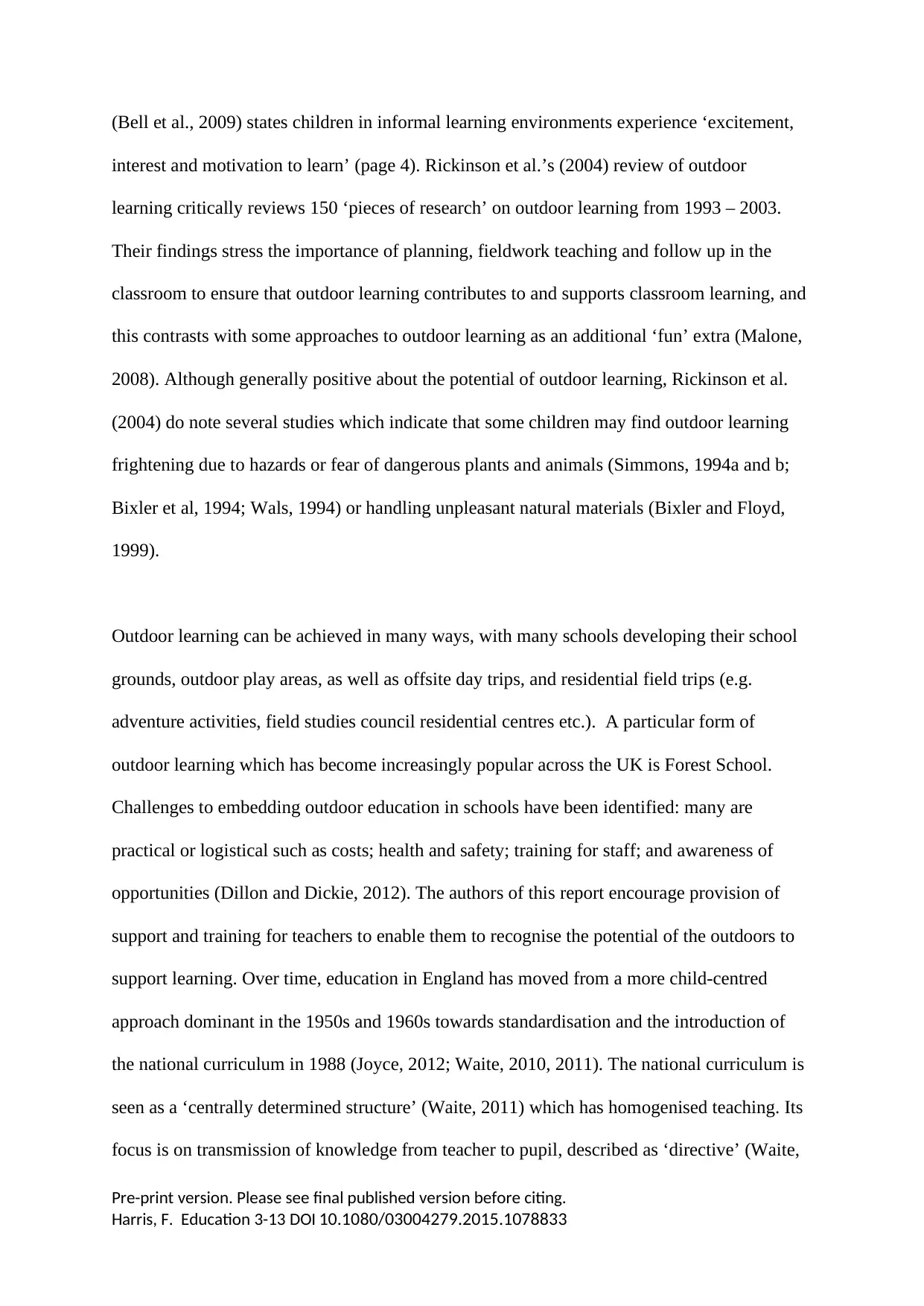
Pre-print version. Please see final published version before citing.
Harris, F. Education 3-13 DOI 10.1080/03004279.2015.1078833
(Bell et al., 2009) states children in informal learning environments experience ‘excitement,
interest and motivation to learn’ (page 4). Rickinson et al.’s (2004) review of outdoor
learning critically reviews 150 ‘pieces of research’ on outdoor learning from 1993 – 2003.
Their findings stress the importance of planning, fieldwork teaching and follow up in the
classroom to ensure that outdoor learning contributes to and supports classroom learning, and
this contrasts with some approaches to outdoor learning as an additional ‘fun’ extra (Malone,
2008). Although generally positive about the potential of outdoor learning, Rickinson et al.
(2004) do note several studies which indicate that some children may find outdoor learning
frightening due to hazards or fear of dangerous plants and animals (Simmons, 1994a and b;
Bixler et al, 1994; Wals, 1994) or handling unpleasant natural materials (Bixler and Floyd,
1999).
Outdoor learning can be achieved in many ways, with many schools developing their school
grounds, outdoor play areas, as well as offsite day trips, and residential field trips (e.g.
adventure activities, field studies council residential centres etc.). A particular form of
outdoor learning which has become increasingly popular across the UK is Forest School.
Challenges to embedding outdoor education in schools have been identified: many are
practical or logistical such as costs; health and safety; training for staff; and awareness of
opportunities (Dillon and Dickie, 2012). The authors of this report encourage provision of
support and training for teachers to enable them to recognise the potential of the outdoors to
support learning. Over time, education in England has moved from a more child-centred
approach dominant in the 1950s and 1960s towards standardisation and the introduction of
the national curriculum in 1988 (Joyce, 2012; Waite, 2010, 2011). The national curriculum is
seen as a ‘centrally determined structure’ (Waite, 2011) which has homogenised teaching. Its
focus is on transmission of knowledge from teacher to pupil, described as ‘directive’ (Waite,
Harris, F. Education 3-13 DOI 10.1080/03004279.2015.1078833
(Bell et al., 2009) states children in informal learning environments experience ‘excitement,
interest and motivation to learn’ (page 4). Rickinson et al.’s (2004) review of outdoor
learning critically reviews 150 ‘pieces of research’ on outdoor learning from 1993 – 2003.
Their findings stress the importance of planning, fieldwork teaching and follow up in the
classroom to ensure that outdoor learning contributes to and supports classroom learning, and
this contrasts with some approaches to outdoor learning as an additional ‘fun’ extra (Malone,
2008). Although generally positive about the potential of outdoor learning, Rickinson et al.
(2004) do note several studies which indicate that some children may find outdoor learning
frightening due to hazards or fear of dangerous plants and animals (Simmons, 1994a and b;
Bixler et al, 1994; Wals, 1994) or handling unpleasant natural materials (Bixler and Floyd,
1999).
Outdoor learning can be achieved in many ways, with many schools developing their school
grounds, outdoor play areas, as well as offsite day trips, and residential field trips (e.g.
adventure activities, field studies council residential centres etc.). A particular form of
outdoor learning which has become increasingly popular across the UK is Forest School.
Challenges to embedding outdoor education in schools have been identified: many are
practical or logistical such as costs; health and safety; training for staff; and awareness of
opportunities (Dillon and Dickie, 2012). The authors of this report encourage provision of
support and training for teachers to enable them to recognise the potential of the outdoors to
support learning. Over time, education in England has moved from a more child-centred
approach dominant in the 1950s and 1960s towards standardisation and the introduction of
the national curriculum in 1988 (Joyce, 2012; Waite, 2010, 2011). The national curriculum is
seen as a ‘centrally determined structure’ (Waite, 2011) which has homogenised teaching. Its
focus is on transmission of knowledge from teacher to pupil, described as ‘directive’ (Waite,
Paraphrase This Document
Need a fresh take? Get an instant paraphrase of this document with our AI Paraphraser
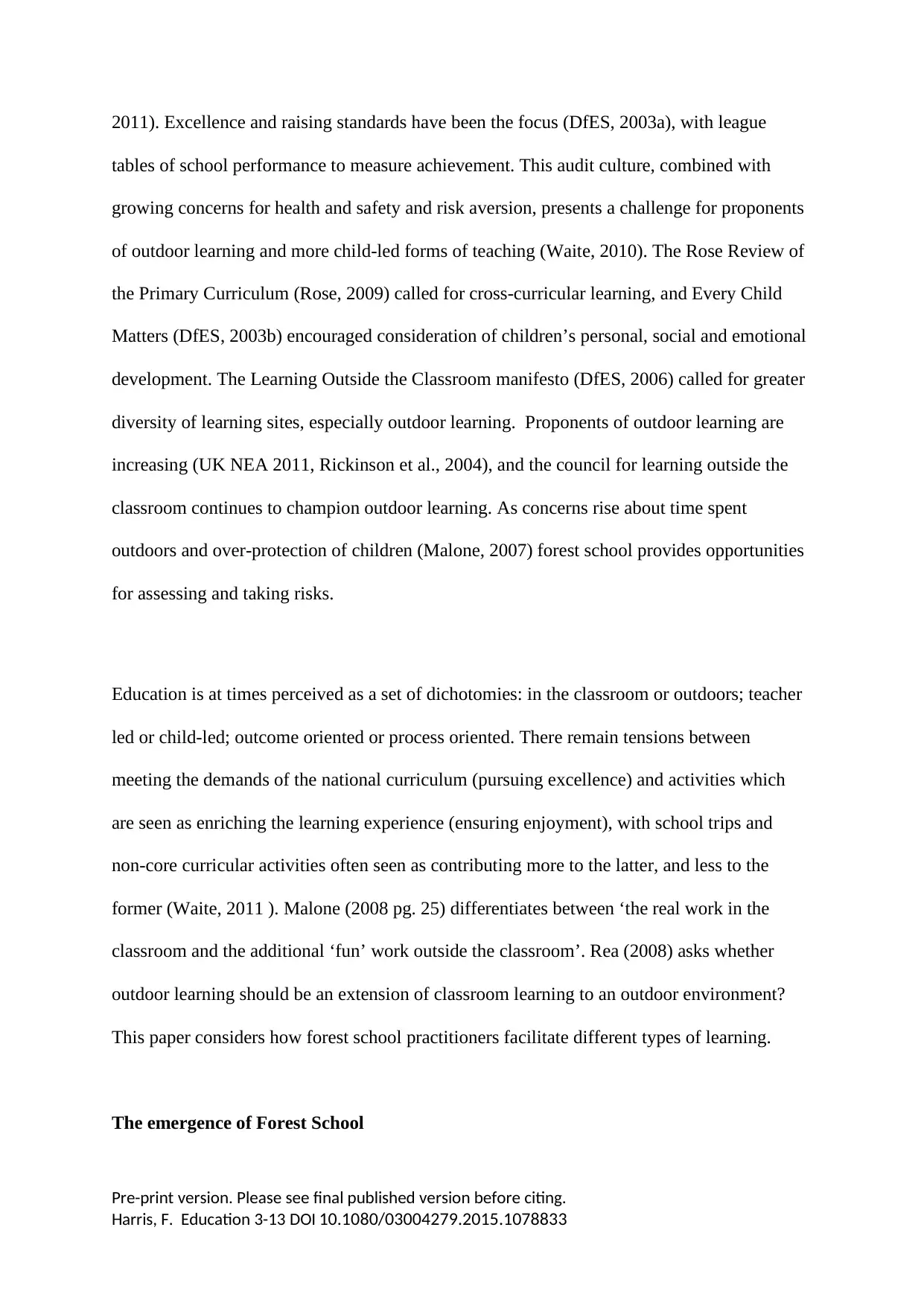
Pre-print version. Please see final published version before citing.
Harris, F. Education 3-13 DOI 10.1080/03004279.2015.1078833
2011). Excellence and raising standards have been the focus (DfES, 2003a), with league
tables of school performance to measure achievement. This audit culture, combined with
growing concerns for health and safety and risk aversion, presents a challenge for proponents
of outdoor learning and more child-led forms of teaching (Waite, 2010). The Rose Review of
the Primary Curriculum (Rose, 2009) called for cross-curricular learning, and Every Child
Matters (DfES, 2003b) encouraged consideration of children’s personal, social and emotional
development. The Learning Outside the Classroom manifesto (DfES, 2006) called for greater
diversity of learning sites, especially outdoor learning. Proponents of outdoor learning are
increasing (UK NEA 2011, Rickinson et al., 2004), and the council for learning outside the
classroom continues to champion outdoor learning. As concerns rise about time spent
outdoors and over-protection of children (Malone, 2007) forest school provides opportunities
for assessing and taking risks.
Education is at times perceived as a set of dichotomies: in the classroom or outdoors; teacher
led or child-led; outcome oriented or process oriented. There remain tensions between
meeting the demands of the national curriculum (pursuing excellence) and activities which
are seen as enriching the learning experience (ensuring enjoyment), with school trips and
non-core curricular activities often seen as contributing more to the latter, and less to the
former (Waite, 2011 ). Malone (2008 pg. 25) differentiates between ‘the real work in the
classroom and the additional ‘fun’ work outside the classroom’. Rea (2008) asks whether
outdoor learning should be an extension of classroom learning to an outdoor environment?
This paper considers how forest school practitioners facilitate different types of learning.
The emergence of Forest School
Harris, F. Education 3-13 DOI 10.1080/03004279.2015.1078833
2011). Excellence and raising standards have been the focus (DfES, 2003a), with league
tables of school performance to measure achievement. This audit culture, combined with
growing concerns for health and safety and risk aversion, presents a challenge for proponents
of outdoor learning and more child-led forms of teaching (Waite, 2010). The Rose Review of
the Primary Curriculum (Rose, 2009) called for cross-curricular learning, and Every Child
Matters (DfES, 2003b) encouraged consideration of children’s personal, social and emotional
development. The Learning Outside the Classroom manifesto (DfES, 2006) called for greater
diversity of learning sites, especially outdoor learning. Proponents of outdoor learning are
increasing (UK NEA 2011, Rickinson et al., 2004), and the council for learning outside the
classroom continues to champion outdoor learning. As concerns rise about time spent
outdoors and over-protection of children (Malone, 2007) forest school provides opportunities
for assessing and taking risks.
Education is at times perceived as a set of dichotomies: in the classroom or outdoors; teacher
led or child-led; outcome oriented or process oriented. There remain tensions between
meeting the demands of the national curriculum (pursuing excellence) and activities which
are seen as enriching the learning experience (ensuring enjoyment), with school trips and
non-core curricular activities often seen as contributing more to the latter, and less to the
former (Waite, 2011 ). Malone (2008 pg. 25) differentiates between ‘the real work in the
classroom and the additional ‘fun’ work outside the classroom’. Rea (2008) asks whether
outdoor learning should be an extension of classroom learning to an outdoor environment?
This paper considers how forest school practitioners facilitate different types of learning.
The emergence of Forest School
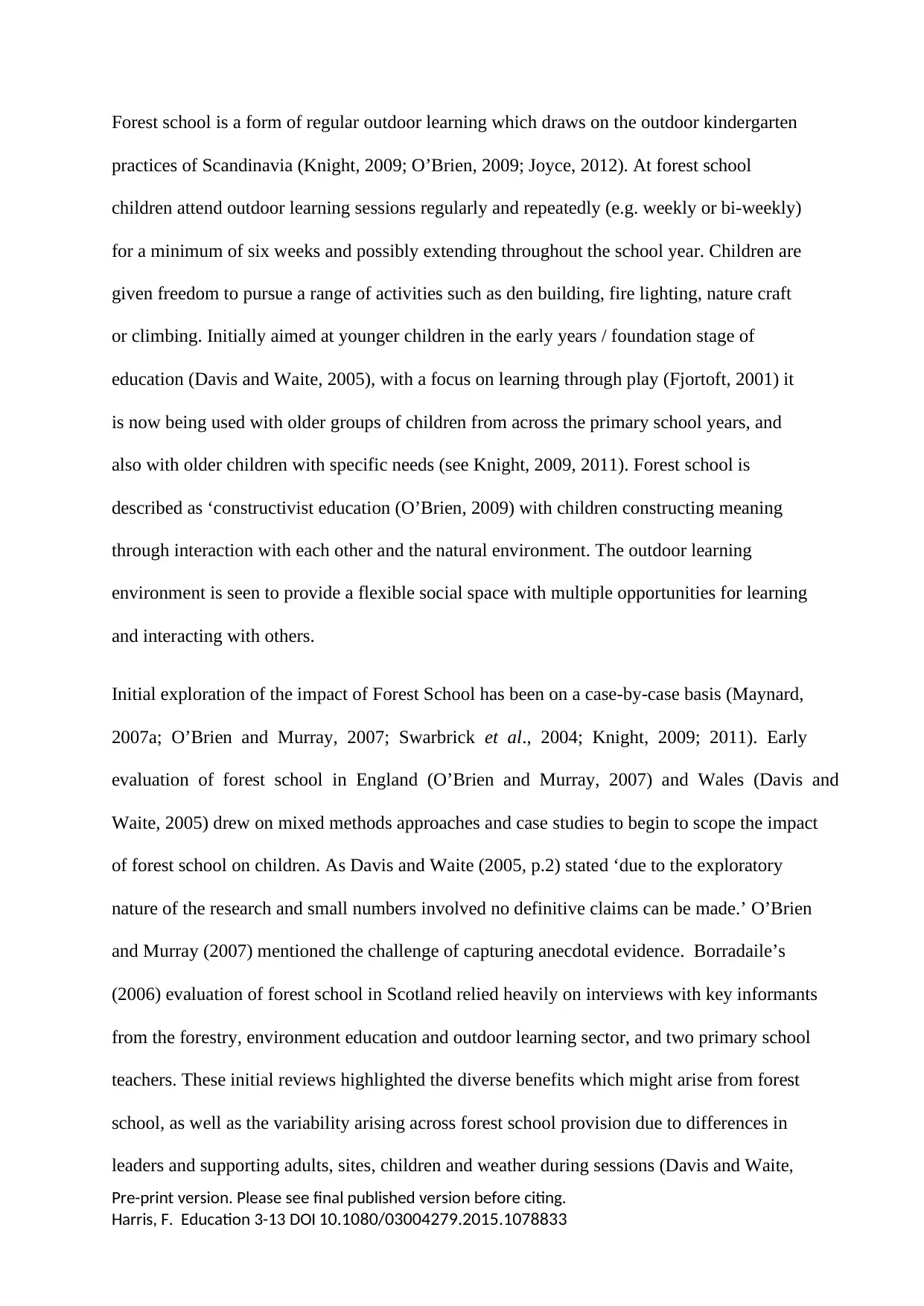
Pre-print version. Please see final published version before citing.
Harris, F. Education 3-13 DOI 10.1080/03004279.2015.1078833
Forest school is a form of regular outdoor learning which draws on the outdoor kindergarten
practices of Scandinavia (Knight, 2009; O’Brien, 2009; Joyce, 2012). At forest school
children attend outdoor learning sessions regularly and repeatedly (e.g. weekly or bi-weekly)
for a minimum of six weeks and possibly extending throughout the school year. Children are
given freedom to pursue a range of activities such as den building, fire lighting, nature craft
or climbing. Initially aimed at younger children in the early years / foundation stage of
education (Davis and Waite, 2005), with a focus on learning through play (Fjortoft, 2001) it
is now being used with older groups of children from across the primary school years, and
also with older children with specific needs (see Knight, 2009, 2011). Forest school is
described as ‘constructivist education (O’Brien, 2009) with children constructing meaning
through interaction with each other and the natural environment. The outdoor learning
environment is seen to provide a flexible social space with multiple opportunities for learning
and interacting with others.
Initial exploration of the impact of Forest School has been on a case-by-case basis (Maynard,
2007a; O’Brien and Murray, 2007; Swarbrick et al., 2004; Knight, 2009; 2011). Early
evaluation of forest school in England (O’Brien and Murray, 2007) and Wales (Davis and
Waite, 2005) drew on mixed methods approaches and case studies to begin to scope the impact
of forest school on children. As Davis and Waite (2005, p.2) stated ‘due to the exploratory
nature of the research and small numbers involved no definitive claims can be made.’ O’Brien
and Murray (2007) mentioned the challenge of capturing anecdotal evidence. Borradaile’s
(2006) evaluation of forest school in Scotland relied heavily on interviews with key informants
from the forestry, environment education and outdoor learning sector, and two primary school
teachers. These initial reviews highlighted the diverse benefits which might arise from forest
school, as well as the variability arising across forest school provision due to differences in
leaders and supporting adults, sites, children and weather during sessions (Davis and Waite,
Harris, F. Education 3-13 DOI 10.1080/03004279.2015.1078833
Forest school is a form of regular outdoor learning which draws on the outdoor kindergarten
practices of Scandinavia (Knight, 2009; O’Brien, 2009; Joyce, 2012). At forest school
children attend outdoor learning sessions regularly and repeatedly (e.g. weekly or bi-weekly)
for a minimum of six weeks and possibly extending throughout the school year. Children are
given freedom to pursue a range of activities such as den building, fire lighting, nature craft
or climbing. Initially aimed at younger children in the early years / foundation stage of
education (Davis and Waite, 2005), with a focus on learning through play (Fjortoft, 2001) it
is now being used with older groups of children from across the primary school years, and
also with older children with specific needs (see Knight, 2009, 2011). Forest school is
described as ‘constructivist education (O’Brien, 2009) with children constructing meaning
through interaction with each other and the natural environment. The outdoor learning
environment is seen to provide a flexible social space with multiple opportunities for learning
and interacting with others.
Initial exploration of the impact of Forest School has been on a case-by-case basis (Maynard,
2007a; O’Brien and Murray, 2007; Swarbrick et al., 2004; Knight, 2009; 2011). Early
evaluation of forest school in England (O’Brien and Murray, 2007) and Wales (Davis and
Waite, 2005) drew on mixed methods approaches and case studies to begin to scope the impact
of forest school on children. As Davis and Waite (2005, p.2) stated ‘due to the exploratory
nature of the research and small numbers involved no definitive claims can be made.’ O’Brien
and Murray (2007) mentioned the challenge of capturing anecdotal evidence. Borradaile’s
(2006) evaluation of forest school in Scotland relied heavily on interviews with key informants
from the forestry, environment education and outdoor learning sector, and two primary school
teachers. These initial reviews highlighted the diverse benefits which might arise from forest
school, as well as the variability arising across forest school provision due to differences in
leaders and supporting adults, sites, children and weather during sessions (Davis and Waite,
⊘ This is a preview!⊘
Do you want full access?
Subscribe today to unlock all pages.

Trusted by 1+ million students worldwide
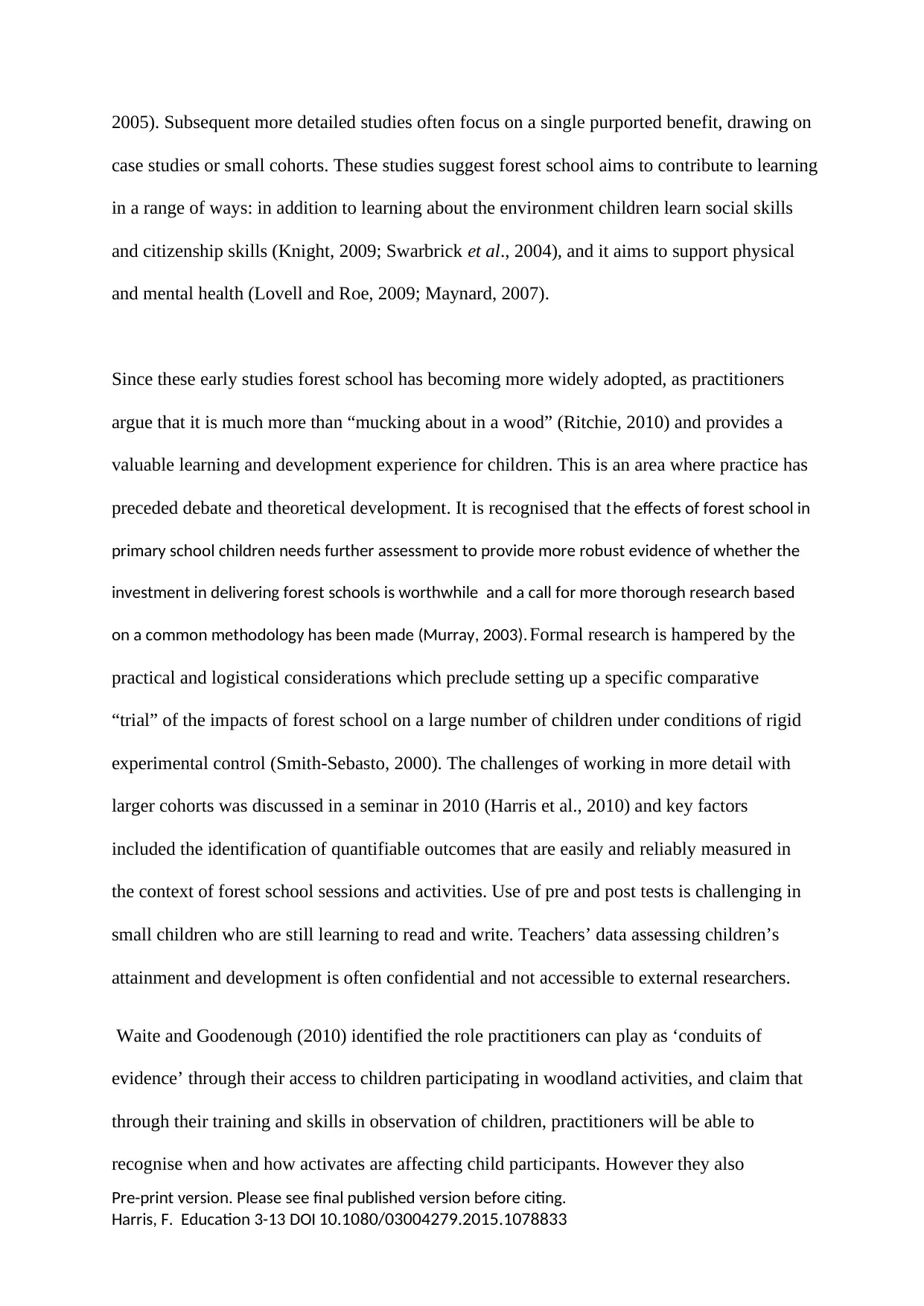
Pre-print version. Please see final published version before citing.
Harris, F. Education 3-13 DOI 10.1080/03004279.2015.1078833
2005). Subsequent more detailed studies often focus on a single purported benefit, drawing on
case studies or small cohorts. These studies suggest forest school aims to contribute to learning
in a range of ways: in addition to learning about the environment children learn social skills
and citizenship skills (Knight, 2009; Swarbrick et al., 2004), and it aims to support physical
and mental health (Lovell and Roe, 2009; Maynard, 2007).
Since these early studies forest school has becoming more widely adopted, as practitioners
argue that it is much more than “mucking about in a wood” (Ritchie, 2010) and provides a
valuable learning and development experience for children. This is an area where practice has
preceded debate and theoretical development. It is recognised that the effects of forest school in
primary school children needs further assessment to provide more robust evidence of whether the
investment in delivering forest schools is worthwhile and a call for more thorough research based
on a common methodology has been made (Murray, 2003). Formal research is hampered by the
practical and logistical considerations which preclude setting up a specific comparative
“trial” of the impacts of forest school on a large number of children under conditions of rigid
experimental control (Smith-Sebasto, 2000). The challenges of working in more detail with
larger cohorts was discussed in a seminar in 2010 (Harris et al., 2010) and key factors
included the identification of quantifiable outcomes that are easily and reliably measured in
the context of forest school sessions and activities. Use of pre and post tests is challenging in
small children who are still learning to read and write. Teachers’ data assessing children’s
attainment and development is often confidential and not accessible to external researchers.
Waite and Goodenough (2010) identified the role practitioners can play as ‘conduits of
evidence’ through their access to children participating in woodland activities, and claim that
through their training and skills in observation of children, practitioners will be able to
recognise when and how activates are affecting child participants. However they also
Harris, F. Education 3-13 DOI 10.1080/03004279.2015.1078833
2005). Subsequent more detailed studies often focus on a single purported benefit, drawing on
case studies or small cohorts. These studies suggest forest school aims to contribute to learning
in a range of ways: in addition to learning about the environment children learn social skills
and citizenship skills (Knight, 2009; Swarbrick et al., 2004), and it aims to support physical
and mental health (Lovell and Roe, 2009; Maynard, 2007).
Since these early studies forest school has becoming more widely adopted, as practitioners
argue that it is much more than “mucking about in a wood” (Ritchie, 2010) and provides a
valuable learning and development experience for children. This is an area where practice has
preceded debate and theoretical development. It is recognised that the effects of forest school in
primary school children needs further assessment to provide more robust evidence of whether the
investment in delivering forest schools is worthwhile and a call for more thorough research based
on a common methodology has been made (Murray, 2003). Formal research is hampered by the
practical and logistical considerations which preclude setting up a specific comparative
“trial” of the impacts of forest school on a large number of children under conditions of rigid
experimental control (Smith-Sebasto, 2000). The challenges of working in more detail with
larger cohorts was discussed in a seminar in 2010 (Harris et al., 2010) and key factors
included the identification of quantifiable outcomes that are easily and reliably measured in
the context of forest school sessions and activities. Use of pre and post tests is challenging in
small children who are still learning to read and write. Teachers’ data assessing children’s
attainment and development is often confidential and not accessible to external researchers.
Waite and Goodenough (2010) identified the role practitioners can play as ‘conduits of
evidence’ through their access to children participating in woodland activities, and claim that
through their training and skills in observation of children, practitioners will be able to
recognise when and how activates are affecting child participants. However they also
Paraphrase This Document
Need a fresh take? Get an instant paraphrase of this document with our AI Paraphraser
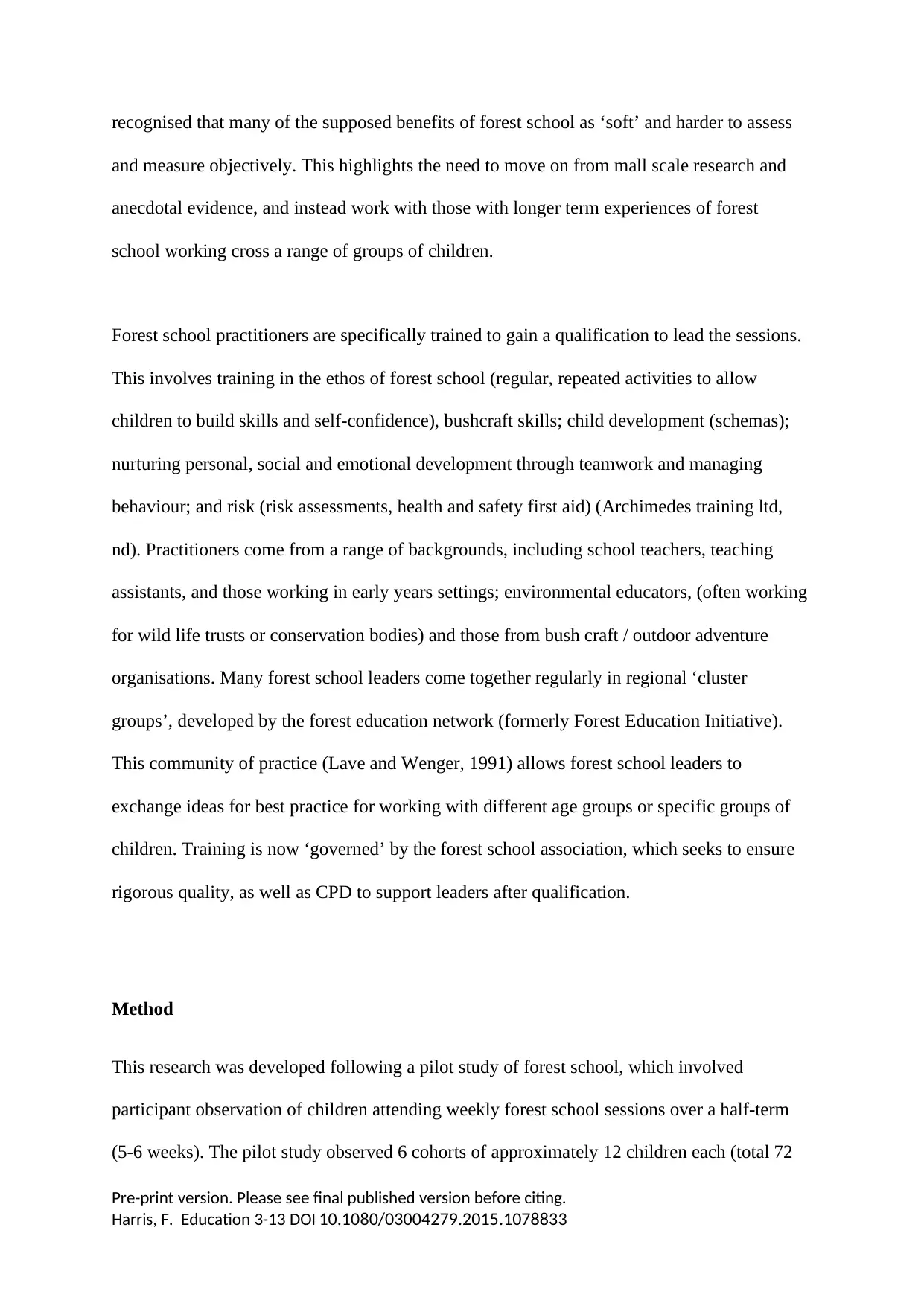
Pre-print version. Please see final published version before citing.
Harris, F. Education 3-13 DOI 10.1080/03004279.2015.1078833
recognised that many of the supposed benefits of forest school as ‘soft’ and harder to assess
and measure objectively. This highlights the need to move on from mall scale research and
anecdotal evidence, and instead work with those with longer term experiences of forest
school working cross a range of groups of children.
Forest school practitioners are specifically trained to gain a qualification to lead the sessions.
This involves training in the ethos of forest school (regular, repeated activities to allow
children to build skills and self-confidence), bushcraft skills; child development (schemas);
nurturing personal, social and emotional development through teamwork and managing
behaviour; and risk (risk assessments, health and safety first aid) (Archimedes training ltd,
nd). Practitioners come from a range of backgrounds, including school teachers, teaching
assistants, and those working in early years settings; environmental educators, (often working
for wild life trusts or conservation bodies) and those from bush craft / outdoor adventure
organisations. Many forest school leaders come together regularly in regional ‘cluster
groups’, developed by the forest education network (formerly Forest Education Initiative).
This community of practice (Lave and Wenger, 1991) allows forest school leaders to
exchange ideas for best practice for working with different age groups or specific groups of
children. Training is now ‘governed’ by the forest school association, which seeks to ensure
rigorous quality, as well as CPD to support leaders after qualification.
Method
This research was developed following a pilot study of forest school, which involved
participant observation of children attending weekly forest school sessions over a half-term
(5-6 weeks). The pilot study observed 6 cohorts of approximately 12 children each (total 72
Harris, F. Education 3-13 DOI 10.1080/03004279.2015.1078833
recognised that many of the supposed benefits of forest school as ‘soft’ and harder to assess
and measure objectively. This highlights the need to move on from mall scale research and
anecdotal evidence, and instead work with those with longer term experiences of forest
school working cross a range of groups of children.
Forest school practitioners are specifically trained to gain a qualification to lead the sessions.
This involves training in the ethos of forest school (regular, repeated activities to allow
children to build skills and self-confidence), bushcraft skills; child development (schemas);
nurturing personal, social and emotional development through teamwork and managing
behaviour; and risk (risk assessments, health and safety first aid) (Archimedes training ltd,
nd). Practitioners come from a range of backgrounds, including school teachers, teaching
assistants, and those working in early years settings; environmental educators, (often working
for wild life trusts or conservation bodies) and those from bush craft / outdoor adventure
organisations. Many forest school leaders come together regularly in regional ‘cluster
groups’, developed by the forest education network (formerly Forest Education Initiative).
This community of practice (Lave and Wenger, 1991) allows forest school leaders to
exchange ideas for best practice for working with different age groups or specific groups of
children. Training is now ‘governed’ by the forest school association, which seeks to ensure
rigorous quality, as well as CPD to support leaders after qualification.
Method
This research was developed following a pilot study of forest school, which involved
participant observation of children attending weekly forest school sessions over a half-term
(5-6 weeks). The pilot study observed 6 cohorts of approximately 12 children each (total 72
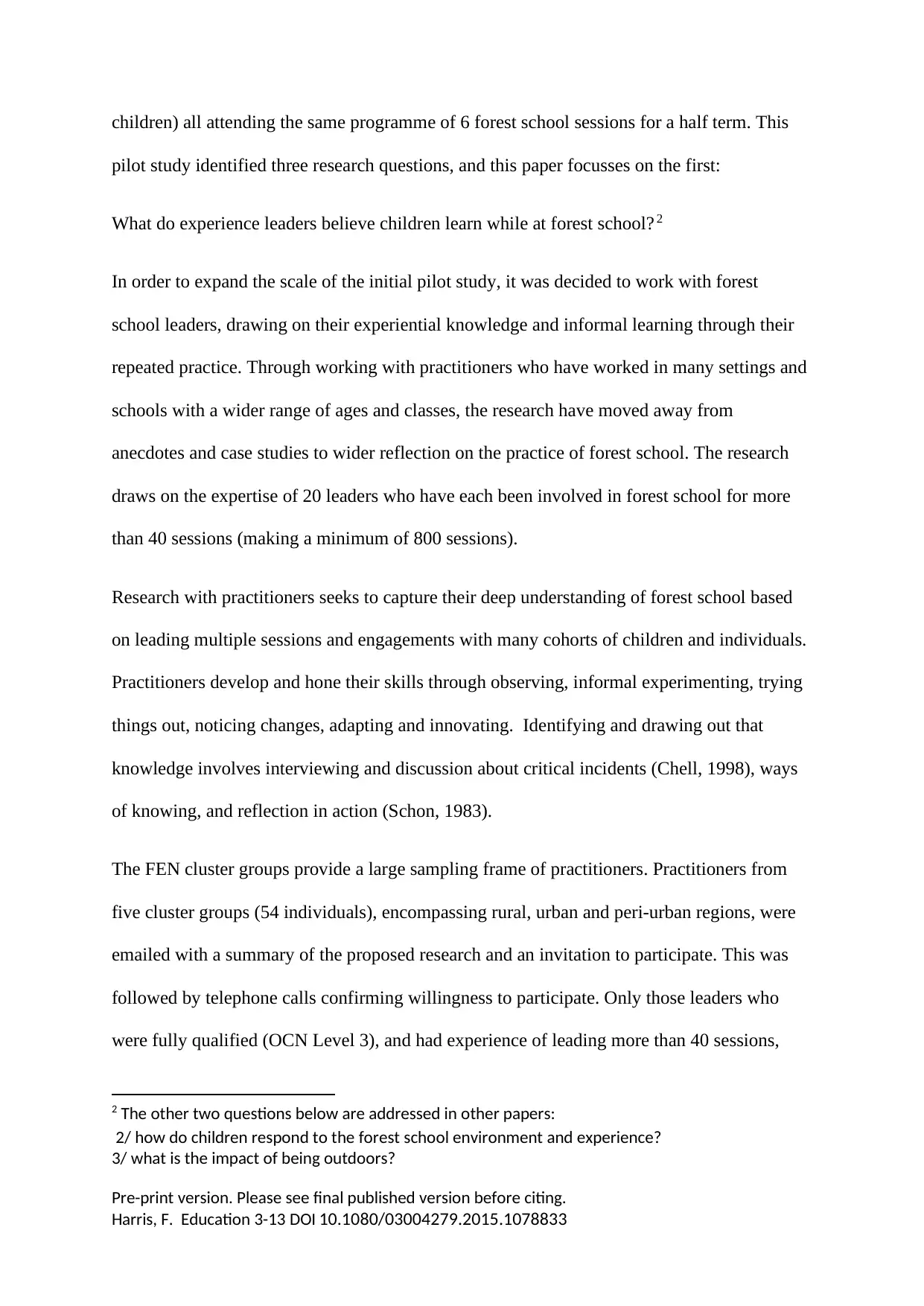
Pre-print version. Please see final published version before citing.
Harris, F. Education 3-13 DOI 10.1080/03004279.2015.1078833
children) all attending the same programme of 6 forest school sessions for a half term. This
pilot study identified three research questions, and this paper focusses on the first:
What do experience leaders believe children learn while at forest school? 2
In order to expand the scale of the initial pilot study, it was decided to work with forest
school leaders, drawing on their experiential knowledge and informal learning through their
repeated practice. Through working with practitioners who have worked in many settings and
schools with a wider range of ages and classes, the research have moved away from
anecdotes and case studies to wider reflection on the practice of forest school. The research
draws on the expertise of 20 leaders who have each been involved in forest school for more
than 40 sessions (making a minimum of 800 sessions).
Research with practitioners seeks to capture their deep understanding of forest school based
on leading multiple sessions and engagements with many cohorts of children and individuals.
Practitioners develop and hone their skills through observing, informal experimenting, trying
things out, noticing changes, adapting and innovating. Identifying and drawing out that
knowledge involves interviewing and discussion about critical incidents (Chell, 1998), ways
of knowing, and reflection in action (Schon, 1983).
The FEN cluster groups provide a large sampling frame of practitioners. Practitioners from
five cluster groups (54 individuals), encompassing rural, urban and peri-urban regions, were
emailed with a summary of the proposed research and an invitation to participate. This was
followed by telephone calls confirming willingness to participate. Only those leaders who
were fully qualified (OCN Level 3), and had experience of leading more than 40 sessions,
2 The other two questions below are addressed in other papers:
2/ how do children respond to the forest school environment and experience?
3/ what is the impact of being outdoors?
Harris, F. Education 3-13 DOI 10.1080/03004279.2015.1078833
children) all attending the same programme of 6 forest school sessions for a half term. This
pilot study identified three research questions, and this paper focusses on the first:
What do experience leaders believe children learn while at forest school? 2
In order to expand the scale of the initial pilot study, it was decided to work with forest
school leaders, drawing on their experiential knowledge and informal learning through their
repeated practice. Through working with practitioners who have worked in many settings and
schools with a wider range of ages and classes, the research have moved away from
anecdotes and case studies to wider reflection on the practice of forest school. The research
draws on the expertise of 20 leaders who have each been involved in forest school for more
than 40 sessions (making a minimum of 800 sessions).
Research with practitioners seeks to capture their deep understanding of forest school based
on leading multiple sessions and engagements with many cohorts of children and individuals.
Practitioners develop and hone their skills through observing, informal experimenting, trying
things out, noticing changes, adapting and innovating. Identifying and drawing out that
knowledge involves interviewing and discussion about critical incidents (Chell, 1998), ways
of knowing, and reflection in action (Schon, 1983).
The FEN cluster groups provide a large sampling frame of practitioners. Practitioners from
five cluster groups (54 individuals), encompassing rural, urban and peri-urban regions, were
emailed with a summary of the proposed research and an invitation to participate. This was
followed by telephone calls confirming willingness to participate. Only those leaders who
were fully qualified (OCN Level 3), and had experience of leading more than 40 sessions,
2 The other two questions below are addressed in other papers:
2/ how do children respond to the forest school environment and experience?
3/ what is the impact of being outdoors?
⊘ This is a preview!⊘
Do you want full access?
Subscribe today to unlock all pages.

Trusted by 1+ million students worldwide
1 out of 42
Your All-in-One AI-Powered Toolkit for Academic Success.
+13062052269
info@desklib.com
Available 24*7 on WhatsApp / Email
![[object Object]](/_next/static/media/star-bottom.7253800d.svg)
Unlock your academic potential
Copyright © 2020–2025 A2Z Services. All Rights Reserved. Developed and managed by ZUCOL.
